From Project to Partner: How to Turn One-Off Gigs into WordPress Retainers

From Project to Partner: How to Turn One-Off Gigs into WordPress Retainers
Planting the Retainer Seed from Day One
During the Discovery Call: Asking About Long-Term Goals
In the Project Proposal: Mentioning Post-Launch Support
Delivering Excellence: The Best Way to Earn Future Work
What to Include in a WordPress Retainer Service
Proactive Maintenance (Updates, Backups, Security)
Performance & SEO Optimization
Support & Small Development Tasks
Monthly Reporting and Strategy Calls
Pricing and Pitching Your Retainer
Calculating Your Retainer Rate (Value-Based vs. Hourly)
Creating Tiered Retainer Packages
The Retainer Proposal: Highlighting ROI for the Client
References
From Project to Partner: How to Turn One-Off Gigs into WordPress Retainers
Planting the Retainer Seed from Day One
During the Discovery Call: Asking About Long-Term Goals
In the Project Proposal: Mentioning Post-Launch Support
Delivering Excellence: The Best Way to Earn Future Work
What to Include in a WordPress Retainer Service
Proactive Maintenance (Updates, Backups, Security)
Performance & SEO Optimization
Support & Small Development Tasks
Monthly Reporting and Strategy Calls
Pricing and Pitching Your Retainer
Calculating Your Retainer Rate (Value-Based vs. Hourly)
Creating Tiered Retainer Packages
The Retainer Proposal: Highlighting ROI for the Client
References
Posted Jul 6, 2025
Stop the feast-or-famine cycle. Learn how to convert your one-time WordPress projects into stable, recurring revenue with retainer agreements.










